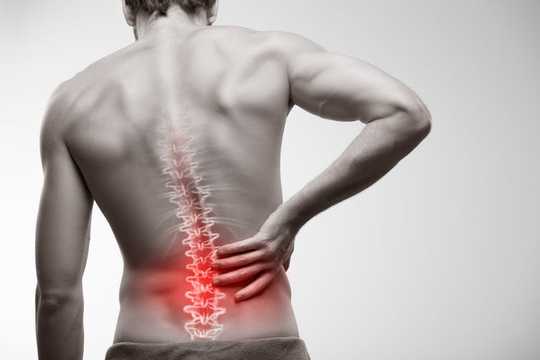Chronic pain – acute pain that lasts for longer than three months – affects around one in five people in Europe. The increase in use of strong morphine-type drugs (opioids) for the treatment of chronic pain is an area of much concern, particularly in North America.
Termed an “opioid epidemic”, most developed countries have seen a major increase in opioid prescribing over the last decade or so. Our latest research assesses how good the evidence is that opioids can help chronic pain effectively, balanced against any harms they can cause.
Chronic pain very often doesn’t get better, so people can be prescribed opioids for a long time – years, or even decades. Is there evidence that opioids continue to work well to reduce chronic pain and improve quality of life? The majority of clinical trials only study opioid use for three months, so we don’t really know much about their effectiveness over the longer term.
One of the few studies that has looked at how effective opioids are after 12 months, found that people who took opioid painkillers were not any more active than those on other types of painkillers.
Get The Latest By Email
There is also evidence that long-term use of opioids may be harmful. This is likely to be dose-related as risks increase at higher doses. Known harms include increased risks of:
-
Addiction and misuse: this can affect anyone who is prescribed opioids for pain. Prescribers and patients need to be aware of, and minimise, the risk from the beginning.
-
Overdose and death: deaths from prescription opioids are increasing dramatically in the US for example.
-
Interfering with the endocrine system: changes in hormone levels that can impact on sexual function and fertility.
-
Heart problems: heart attack risk is more than doubled in people taking long-term opioids.
-
Being in a road traffic accident: the risk is higher among drivers taking even relatively low doses of opioids.
-
Worsening pain or “opioid-induced hyperalgesia”: when long-term use makes pain worse. This is often difficult to recognise.
-
Opioid tolerance: when the body becomes used to opioids and requires a bigger dose to get the same painkilling effect.
-
Adverse effects on the immune system: people taking opioids eventually become more prone to infections.

One in five Europeans suffers from chronic pain. Shutterstock
Should we use opioids for chronic pain?
Yes, when appropriate – but with caution. The Scottish Intercollegiate Guideline Network (SIGN) publishes high-quality evidence-based management guidelines. SIGN 136 was the first comprehensive guideline on the management of chronic pain, published in 2013.
As a result of new evidence, SIGN 136 has specifically reviewed the section on opioid use and updated recommendations have recently been published. New research since 2013 has been critically reviewed to ensure that the new recommendations are based on the best available evidence. Some of the key points in the new advice include the following:
-
Opioids should be used for as short a time as possible, in carefully selected people with chronic pain. This should happen when other treatments haven’t worked to manage the pain and where the benefits outweigh the risks of the serious harms listed above.
-
Before starting treatment, the person with chronic pain and the prescriber should agree what the treatment aims are. These might include reduced pain, increased activity and/or better quality of life. If this doesn’t happen then there should be an agreed action plan to reduce and stop opioids.
-
There should be ongoing, regular review by a member of the primary healthcare team, especially if the daily dose is equivalent to more than 50mg of morphine. Review should be frequent in the early stages, and at least annually, after treatment is established. If problems arise – such as opioids no longer providing good pain relief, increasing the dose provides no sustained pain relief or then there is evidence of addiction – then more frequent review will be needed and consideration given to reducing/stopping treatment.
-
We should always use the lowest effective dose. Higher doses (equivalent to more than 90mg/day of morphine) should only be prescribed alongside review by a pain specialist.
These recommendations are consistent with those of The International Association for the Study of Pain (IASP). The organisation emphasises that the use of other approaches, including behavioural therapies and increasing physical activity to improve quality of life, is preferred.
Where do we go from here?
Current evidence indicates that widespread, long-term opioid prescribing for chronic pain is likely to cause more harm than benefit in society. But some individuals with chronic pain do benefit. They should continue to be prescribed opioids, with the recommended caution, careful monitoring and review, and use of proven non-pharmacological therapies. Some people may also need support to reduce and stop long-term opioids, where the harms outweigh the benefits.
There is an urgent need for research to understand how to manage chronic pain better, including the safe use of and withdrawal from opioids. In tandem we need national policies, based on best available evidence and approaches to educate healthcare professionals and patients. This is likely to require investment in the short term, but it may be a small price to pay for the longer term benefits and probable cost savings of improving chronic pain management, which is the leading cause of disability globally.![]()
About the Authors
Lesley Colvin, Deputy Head of Division - Population Health & Genomics & Chair in Pain Medicine, University of Dundee and Blair H. Smith, Professor of Population Health Science, University of Dundee
This article is republished from The Conversation under a Creative Commons license. Read the original article.
books_health








